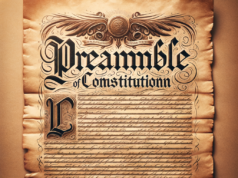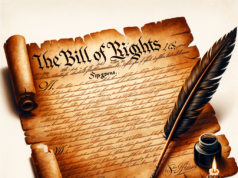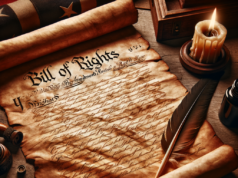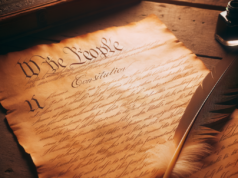Table of Contents
- 1 The Background of the Constitutional Convention and Prior Attempts
- 2 George Washington and his Importance as Presiding Officer
- 3 Virginia Plan
- 4 New Jersey Plan
- 5 Connecticut Compromise
- 6 Approach to Slavery
- 7 Constitution Authors and Signers
- 8 State Ratification Process
- 9 Fathers/Framers of the Constitution

The Constitutional Convention is a significant event in American history as it led to the drafting of the United States Constitution, which established the foundation of the American government and has become an essential document for the country’s legal system. The Convention was held in Philadelphia in 1787 and brought together some of the most influential political leaders of that time.
The Constitutional Convention was necessary because many of the weaknesses in the Articles of Confederation, which had been the governing document since 1781, became apparent. For example, the lack of a centralized government led to a weak national defense and inconsistent regulation of commerce between states. Therefore, the Constitutional Convention was intended to revise the Articles of Confederation to make them more effective.
Delegates from twelve states attended the Convention, with Rhode Island abstaining. 55 delegates participated, including notable figures such as George Washington, James Madison, Benjamin Franklin, and Alexander Hamilton. Washington was elected the presiding officer of the convention, and the participants decided to keep the deliberations secret to encourage open discussion and decision-making without fear of public scrutiny.
The Convention’s primary objective was to create a new governing document that addresses the weaknesses of the Articles of Confederation while continuing to protect individual liberties. The delegates ultimately drafted the Constitution, a document that outlined the structure of the federal government, the division of powers between branches, the powers of the national government, and the power of the states.
Many debates ensued during the Constitutional Convention, with delegates representing differing opinions and beliefs. The most contentions issues were representation in Congress, slavery, and the power of the executive. Key compromises were essential for the success of the Constitution, including the Great Compromise, which established the framework for the legislative branch. The Three-Fifths Compromise allowed Southern slaveholding states to count only a fraction of their slave population for representation in Congress.
The Convention lasted for four months, beginning May 25, 1787, and concluding on September 17, 1787, when the final draft of the Constitution was signed. The document sets up the framework of the federal government, including the president, the Congress, and the Supreme Court, and was designed to balance power between the states and the national government.
The Constitution has been amended and interpreted over time to uphold the fundamental principles of democracy and liberty enshrined in its original text. The Constitution’s longevity and continued impact reaffirm the essential role of the Constitutional Convention and the commitment of the Founding Fathers to creating a just and democratic government.
In conclusion, the Constitutional Convention was the turning point in American history that brought together leaders from all of the colonies to discuss and establish a new governing document that would endure for centuries. The Convention led to the drafting of the United States Constitution, which has served as the guiding principle for the country’s legal system and government. The Constitution’s principles of democracy, liberty, and justice embody the essence of American ideals; and for this, the Constitutional Convention is an important event that will always be remembered in American history.
The Background of the Constitutional Convention and Prior Attempts
The precepts set forth in the Articles of Confederation, both on a legislative level as well as a national level, had all but languished the United States. Due to the general unrest in interstate relations, as well as a growing animosity on the part of a majority of the European world powers, all as a result of a lack of a nationalized domestic and interstate diplomatic policy, the economy of the United States was nearing collapse. This dynamic was elucidated when George Washington held a conference at his home in Mount Vernon, Virginia in order to establish a process by which to traverse the Potomac River, a river that spanned the borders of multiple states.
The representatives at the conference at Mount Vernon quickly realized that even a seemingly simple process, such as navigating a river, was needlessly complex if not impossible, all due to the dysfunctional legislative model presented in the Articles of Confederation. Political figureheads such as Alexander Hamilton, Benjamin Franklin, and John Adams agreed that a new legislative doctrine was imperative and, as a result, the Constitutional Convention was organized and set into motion in 1787.
George Washington and his Importance as Presiding Officer
A delegate from Virginia sent to the Constitutional Convention was primarily recognized for his service as the commander of the Continental Army throughout the Revolutionary War, not for his political or philosophical acumen. However, much to his own bewilderment, George Washington was unanimously nominated to preside over the Constitutional Convention by the entirety of the delegates who were also sent to represent their respective states in the proceedings of the Convention. Although initially declining his nomination, George Washington eventually accepted the position at the unanimous behest of his fellow delegates.
Unbeknown to George Washington, it was his tireless dedication and service to the well-being of the United States of America that had inspired his unanimous nomination. Neither identifying himself as a Federalist nor a Sovereigntist, George Washington was the penultimate example of a patriot whose only concern was the prosperity of a nation that he not only loved so dearly but for which he was also willing to give his life.
Virginia Plan
The Virginia Plan was a proposition offered by Virginia delegate Edmund Rudolph at the Constitutional Convention – also known as the Philadelphia Convention – with the hopes of securing a definitive selection process for a national, consolidated legislative body. The Virginia Plan was based on a bicameral legislative model, which included two tiers of Congress: the Upper House and the Lower House. The Lower House would be elected in accordance with each individual State’s population. Afterward, the Upper House would be elected by the Lower House. As a result, states with larger populations would be unable to rely solely on their size, and states with smaller populations would not be unable to form alliances.
In addition, a bicameral legislature would ensure that a single state, or a ‘minority’, would be unable to decide the fate of the majority. However, it came as no surprise that the smaller states attending the Philadelphia Convention viewed the Virginia Plan as unfairly partial to states with larger populations.
New Jersey Plan
The New Jersey Plan was created by New Jersey State delegate William Paterson and presented to the Constitutional Convention. The New Jersey Plan, also known as the Small State Plan, was a system set forth to determine the selection process of State representatives to a consolidated, Congressional legislative body. Furthermore, there would only exist a single Congressional legislative body.
William Paterson’s New Jersey Plan consisted of unicameral legislation in which each state, regardless of size, would be entitled to an equal number of representatives admitted to a Congressional legislative body. William Paterson created his New Jersey Plan with the hopes of preventing the respective size of a state from becoming a deciding factor in the establishment of any sort of legislative process. As a result, smaller states would be denied the opportunity to create unjust alliances and larger states would not be entitled to greater indulgences due to their larger size.
Connecticut Compromise
An absence of a confirmed methodology in regards to a selection process establishing an individual State legislature to Congress, the prospect of the rejection of the Constitution became an impending reality. The rejections of both a unicameral legislature proposed in the New Jersey Plan and a bicameral legislature proposed in the Virginia Plan made an immediate solution to rectify the discord imperative.
Roger Sherman, a politician from Connecticut, suggested his Connecticut Plan – also referred to as The Great Compromise – as a means to unify the individual states in collective, nationwide ratification of the Constitution. Converging the methods illustrated in both the New Jersey Plan and the Virginia Plan, the Connecticut Plan outlined a structural process with the hopes of a fair, balanced, and practical strategy to appoint a State legislature which factored in population size, as well as the desire to dismiss any potential favoritism allowed to states as a result of their respective sizes.
The Connecticut Plan outlined a bicameral legislature that would be comprised of two legislative bodies: the House of Representatives and the Senate. The selection process for the House of Representatives would be commensurate with a state’s population, while that for the Senate would be uniform amongst all states.
Approach to Slavery
Alongside a process to select the legislature, the debate over slavery and its undetermined presence in the future of the United States was a deciding factor in the ultimate ratification of the Constitution. Many of the southern states of the Union, Georgia and North Carolina being the most prominent, were adamant about the preservation of slavery in the United States. Although many of the northern states, along with many of their respective representatives, were ferociously opposed to the moral and ethical turpitude that slavery enabled, a majority of the southern states maintained that both the preservation of their respective economies, as well as their general prosperity, was reliant on slave labor.
As the process of ratification continued, many of the framers of the Constitution became aware that certain disagreements about tenets of the Constitution could prevent the ultimate ratification of the Constitution. As a result, they created a gag rule in regard to the debate about the slave trade. The gag rule stated that although slavery would be permitted at the time, its presence could be reevaluated in no less than twenty years.
Constitution Authors and Signers
There were 55 signers of the Constitution, all of whom were comprised of State representatives from 12 of the 13 states of the Union. The only State absent from the ratification process of the document was Rhode Island, which contended that they were summarily dissatisfied with both the methodology and practices proposed within the text.
The authorship of the Constitution is far more ambiguous. The Constitution of the United States is considered by most historians to be a comprehensive restructuring of the Articles of Confederation under the pretense of a definitive Federalist influence. Although the physical penning of the Constitution was done by Governor Morris, the credit of the ideology, methodology, and vision has been credited not to a single individual, but instead to a network of political figureheads and thinkers, including John Adams, Thomas Jefferson, Alexander Hamilton, and James Madison.
State Ratification Process
The journey leading to the ratification of the Constitution was a long and arduous one, complete with an overarching concern on the part of all involved of its impending rejection. Due to the various concerns of the 13 individual states of the Union, the prospect of creating a single, unanimous doctrine that both encompassed an American ideology, as well as addressed the individual interests of each state, the future of the Constitution was transient up until its ultimate ratification.
The Connecticut Compromise addressed the concerns of both smaller states, as well as larger states in its methodology of a state-specific legislative selection process. The Massachusetts Plan ensured the presence of a clause that would allow for future amendments to the Constitution; the gag rule regarding the slave trade ensured the participation of the southern states in the ratification process. With respect to its approval contingent upon 9 out of 13 states, the Constitution was finally ratified. The respective approvals of Virginia and North Carolina arrived months after, while Rhode Island completely abstained.
Fathers/Framers of the Constitution
Although no definitive accreditation exists with regard to a ‘father’ of the Constitution, historians consider the men involved both in its authorship, as well as its inception, to be the framers, or fathers, of the Constitution. Amongst the main contributors to the Constitution include John Adams, Thomas Jefferson, James Madison, and Alexander Hamilton. However, countless politicos and thinkers have been awarded the honor of framing the Constitution.
Attributes for those considered to be framers, or fathers, of the Constitution, consist of a presence and participation in the Revolutionary War – physically and politically. Furthermore, all of the framers of the Constitution lived underneath the Articles of Confederation and were privy to its perceived flaws. Finally, those bestowed with the title of “framer(s) of the Constitution” are considered to be comprised of men who were present at both the Constitutional Convention, as well as the signing process subsequent to the nationwide approval.
However, it is important to mention that both John Adams and Thomas Jefferson – both of whom are primarily credited with the advent of the Constitution – were not present during its signing. They were in Europe on a diplomatic assignment.
























